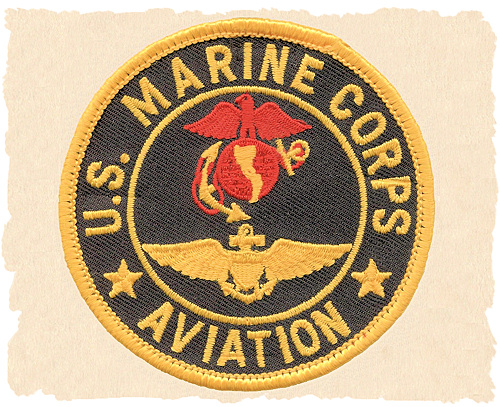VMF-224 Scrap Book
Lindbergh Visits Roi-Namur
Combat testing the F4U with MAG-31
Charles Lindbergh visits Marine Air Group 31 Squadrons based on Roi-Namur
Selected text from "The Wartime Journals of Charles A. Lindbergh"
Thursday, August 31, 1944
Landed at Kwajalein at 12:32. Took ferry across to Ebeye Island to arrange for further orders and clearances. Found Captain (John B.) Pearson there. Captain Pearson said Corsair squadrons at Guam have had no air combat. The Navy carrier planes wiped out all Japanese aviation. On his advice I decided to spend several days with Marine Corsair squadrons in the Marshall's instead of going on to Guam and Saipan. Admiral (Alva D.) Bernhard invited me to spend the night with him. He had asked General Wood and several other officers for supper.
Friday, September 1, 1944
Arranged to visit the Marine squadrons at Roi Island. Navy boat to Kwajalein Island. Off in a Navy JRB-4 at 0944. Co-piloted to Roi Island. Landed at 10:05. To MAG-31 headquarters. Colonel Freeman invited me to stay with him while I am on the island. Spent most of the afternoon with squadron officers, discussing the Corsair and fighter characteristics. Have arranged to go on a dive-bombing mission with one of the squadrons tomorrow.
Saturday, September 2, 1944
Took off with squadron at 12:58, carrying a 1,000 pound bomb in place of the belly tank. I was flying the twentieth plane so I could watch the squadron maneuvering. Climbed to 8,000 feet and flew to Taroa Island, Maloelap Atoll, via Wotje Atoll. ……. Our target was a personnel area located by Intelligence from recent low-altitude photographs. We started our dive at 8,000 feet and released at 3,000; angle about 60 degrees; no dive brakes. Most of our bombs landed in or near the area, starting one fuel fire. We encountered moderate and accurate small-arms fire from the ground. The Japanese gunners are still bringing down our planes occasionally. Landed at Roi Island at 15:58.
Sunday, September 3, 1944
Off the strip at 0535, carrying three 1,000 pound bombs. (First time three have been carried on an F4U in this area.) Plane took off easily. Took off ahead of squadrons and cruised at maximum economy to Wotje Atoll. Rendezvoused with squadrons a few minutes after I arrived. I made one run for each of the three bombs, starting at 8,000 and releasing at 3,000 feet. Target: Japanese naval gun positions on shore of Wotje Island. Landed at 0813. Supper and evening with Colonel Freeman and staff officers.
Monday, September 4, 1944
To the line with Colonel Freeman to look into the possibility of installing a 2,000 pound bomb on the F4U, which I suggested as a result of my flight with three 1,000 pound bombs yesterday morning. I am working with a young lieutenant by the name of Clark, and we plan to build a special belly rack for the larger bomb. Took F4U-1 (No. 263) up for a test flight to check the rigging. Made diving tests up to 400 knots indicated at 50 degrees with a 3-G pull-out. Also aerobatics. Plane carries 5 degree left aileron at 7 degrees right rudder. Otherwise O.K. I suggested bending down the fairing strip forward of the left aileron on the bottom wing surface.
Wednesday, September 6, 1944
Tested 2,000 pound bomb installation today. The rack took a permanent set as the bomb was lifted into place. It will have to be reinforced. Colonel Freeman and I to Commander (Lindfield L.) Hunt's quarters, at his phone invitation, in the evening to meet Jack Benny, Carol Landis, and troop. They are completing a two-month tour of the Pacific area and had just finished giving their play for servicemen in the island. The play started at 8:00, and some of the men in the front rows had been sitting there since 3:00, through a half hour heavy rain and wind.
Friday, September 8, 1944
Spent most of the morning inspecting installation and making arrangements for the 2,000 pound bomb dive test. All checks O.K. Off the strip at 1301 hrs. Slight cross wind. Take-off normal. Good climb and control. Started ten minutes ahead of the squadron making the day's strike. Direct course to Wotje Island. Element of surprise important as nearby Jap gun installation is accurate and has brought down two Corsairs in recent weeks.
Started dive downwind from 8,000 feet -- shallower than usual -- to be sure the 2,000 pound bomb would miss the propeller. Released at 3,000 and pulled up quickly, as I was directly over the antiaircraft installations. Bomb hit about 100 yards southeast of building, wiping out several small structures and throwing aa huge column of smoke and debris into the air. So far as we know, this is the first time a 2,000 pound has been dropped by a fighter.
Remained over the island for half an hour, watching the squadron bomb a newly discovered ammunition dump on the north shore. (One direct hit and several nearby hits.) Then followed last planes of squadron back to Roi Island. Landed at 1600 hrs. Bomb rack showed no sign of strain except that a front supporting pin was slightly bent. Gave orders for the hole to be drilled larger and for the pin to be replaced with a bolt.
Saturday, September 9, 1944
Up shortly after sunrise. Natives very friendly. Each one says "good morning" as he passes the screen sides of our hut and expects a "good morning" in reply. Since there are dozens of them passing, we take turns at the game -- one of us nodding and saying "good morning" while the other two dress.
Breakfast with Lieutenant (Kenneth) Collyer, Captain McCall, and other officers. The talk drifts to the original attack and occupation of Roi Island. Most of our American losses were caused by an ammunition dump exploding, one of the officers told me. He had landed D plus 3. The American casualties were buried in individual graves, he said, but the Japanese bodies were loaded in trucks and dumped into a big hollow scooped in the ground by a bulldozer. The natives did much of the handling of the Jap bodies and located many of them by "smelling for them."
We passed under a number of terns as we walked to our boat. It made me realize what an absence of birds there is on the occupied islands. War is like flame. Where it sweeps, life disappears, the birds and the trees with the Japanese. We come with bulldozers and scrape over the surface until it is barren as a gold-dredged area. One of these occupied places of ours is like another all over the world -- the same barrenness, the same tents, the same men, the same wreckage. When you have seen one such place, you have seen them all. Here it may be hot, there it may be cold, but the camp is the same. Only when you get beyond its borders, to the ocean beach, to the outlying island, into the adjoining jungle, do you realize that each portion of the world has a character of its own and that life as it used to be still exists hidden away from war and waiting for a chance to bloom again.
Sunday, September 10, 1944
To the line at 8:00 to check today's target and the bomb installations on my plane. Off the strip at 9:52, taking up a direct course for Wotje Island. Over target at 11:00. It is impossible to realize as one flies over that Japanese troops crouch hidden in dugouts and concrete housing waiting for the rain of death we are about to drop from the sky. It is difficult to realize that the sting of death lies coiled in belts of the machine-gun bullets in those little, harmless looking circles on the ground. One cannot realize that when he presses the little red button on the stick he releases a bomb that may carry death and agony to a hundred men.
Tuesday, September 12, 1944
We strike Wotje Island at 1:45 this afternoon. I am carrying one 2,000 pound bomb and two 1,000 pound bombs - the heaviest bomb load ever attached to an F4U. To the strip at 1145 to be ready for a 1230 take-off. Found a cross wind blowing, with gusts up to fourteen knots. Ordered one of the 1,000 pound bombs taken off, leaving one 2,000 pound and one 1,000 pound bomb attached. Heavy rain squall blew over. Took off immediately afterward. In the air at 1225. (Made a curving take-off because of the cross wind - heading toward a point halfway along and on the windward side of the runway. No trouble getting off, but I apparently had a group of Marines on the windward side of the runway much concerned. They had come out to watch me take off with a 3,000 pound bomb load in the cross wind.) Captain Clark took off behind me, and we set a direct course fpr Wotje, flying ahead of the striking squadron.
Rendezvoused over the lagoon formed by Wotje Atoll. Waited until the squadron completed bombing runs (which were unusually accurate). Then maneuvered into position, rolled over at 8,000 feet, and dove on the radio station at an angle of about 60 degrees. Released the bombs at about 1,800 feet, holding gun sight about twenty-five mils over the target. Was still "grayed out" when bombs exploded. Almost a direct hit. A great column of debris rose in the air, obscuring one end of the radio station. As the debris settled and the smoke drifted away, I could see the bomb crater, larger than the others and just touching one corner of the building. The internal damage must have been considerable. Anything but reinforced concrete walls would have collapsed. Waited for Captain Clark to make his run with the photo plane. Then took up course for home. Landed at 1440.
Wednesday, September 13, 1944
To the line at 7:30 to inspect bomb installation on my plane. I am taking off with one 2,000 pound and two 1,000 pound bombs -- a total bomb load of 4,000 pounds -- which is probably the highest bomb load ever carried by a single-engine fighter.
To Operations for briefing, and off the strip at 0823. Circled the island once while Captain Clark joined me with the photographic plane (F4U). Then took a direct course for Wotje Atoll, climbing at military power to get above a thick layer of broken clouds. Two fighter squadrons were to dive-bomb Wotje Island today. Both squadron leaders radioed to us, asking for a report on the weather ahead. We were in sight of Wotje Atoll at the time and replied that the target was clear. A few minutes later one of the squadrons turned back due to storms.
I flew upwind over my target (a small, concrete block house) at 8,000 feet, rolled over, and started my dive. I was pointed downward at an angle of about 65 degrees, the steepest I have used with a heavy bomb load. I trimmed the plane quickly as the ground approached and then got my fingers around the manual releases for the two 1,000 pound bombs. But I had not rolled the elevator tab far enough forward, and the plane became so tail heavy that I no longer had the strength in my right arm to hold the sight on the target. I was almost down to 2,000 feet. There was not time to re-trim the elevator tab and get my fingers threaded through the bomb release levers again. The present F4U-1D has manual release controls for the two pylon bombs, while we have installed an electrical release for the 2,000 pound center bomb. Therefore, in order to release all three bombs in salvo, it is necessary to pull the two pylon bomb levers with the left hand at the same moment the center bomb release button is pressed with the right thumb.
With a lighter load I could have pulled out and made another dive, but it seemed inadvisable with 4,000 pound of bombs. Fortunately, the area between the block house and the shore was full of Japanese activity and contained several excellent targets. In spite of all the force I could maintain on the stick, the gun sight was creeping rapidly toward the shore line. There was just time. I tripped the bomb releases and pulled up steeply.
When the period of "gray-out" was over, I looked back to see the black column of debris rising above the main naval-gun installation in that are of the island -- a large, reinforced concrete structure jutting out slightly from the shore line. I could not have selected a better target even if it had been intentional, with plenty of time to consider. My bombs had completely wiped out the southern portion of the gun position and probably dislocated the gun itself.
We circled around the island while the squadron which got through made its runs. Then Captain Clark dove down to get his strip of photographs of the bombed area. After that, we rendezvoused over the lagoon and took up course for home. The cloud layer had thickened and the thunderheads were building up. The flight back home was like threading a needle at times -- heading for a narrow tunnel of light between towering columns and then finding another farther on. The landing strip finally appeared under my left wing through a break in the cloud bank. We dove steeply down through the hole, Captain Clark flying an excellent formation. Landed on the strip at 10:43.
The take -off and drop with 4,000 pound of bombs completes the test program I laid out several days ago. Colonel Freeman is flying to Kwajalein Island this afternoon. I decided to go with him. Landed Kawajalein strip at 1553 after a flight across the center of the atoll. We passed over the wreck of a Japanese submarine on one reef and two sunken freighters on another. I stopped at Marine Wing headquarters for a short conference with General Wood in regard to the bomb tests at Roi Island, etc., then took the ferry to Ebeye Island (a twenty minute boat trip). Supper with Admiral Bernhard. Conference with Captain Pearson in the evening.
Thursday, September 14, 1944
To Captain Pearson's office to discuss the Corsair, dive bombing, future fighter requirements, etc., and to arrange for my transportation to the Hawaiian Islands. Captain Pearson told me that the Corsair is going back to Navy carriers and that it may replace the Hellcat as the standard carrier plane in the future. We spent some time discussing the possibility of towing fighters behind bombers -- a subject he is much interested in.
Lunch with Captain Pearson and other naval officers. Took the 1:00 ferry to Kawajalein Island to discuss the towing idea with General Wood and Colonel Freeman. We agree that it is worth further study. Four o'clock ferry back to Ebeye Island. Packed, said my good-by's, and drove to the NATS station at 1800. Off the water at 1839 (0739 G.C.T.) in a PB2Y-3 as passenger. A night take-off. I selected the last seat in the tail, reclined it as much as possible, and went to sleep.
<- (click to view)
<- (click to view)
<- (click to view)
<- (click to view)
<- (click to view)


